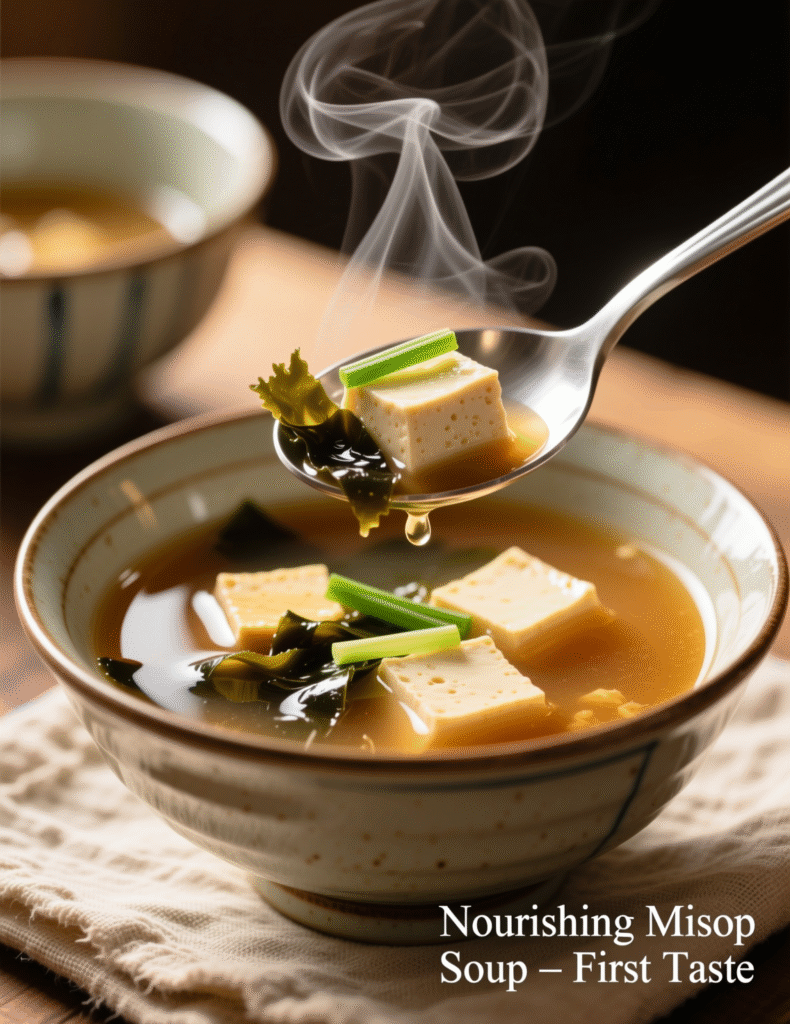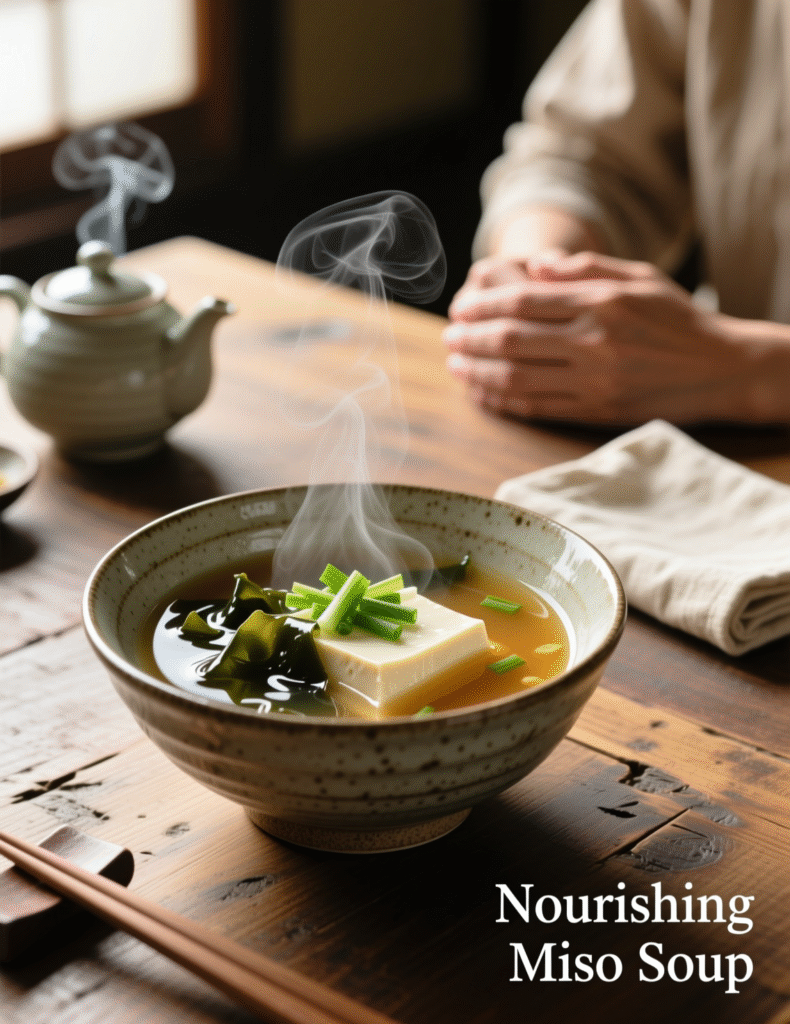There’s something almost poetic about a bowl of miso soup. Steam curling like morning fog, the gentle umami hum hitting your senses before the spoon even dips in. This is not just a soup; it’s a quiet ritual, a moment of calm dressed in seaweed and tofu. But making a truly nourishing miso soup—the kind that tastes like it came straight out of a small Tokyo kitchen—takes more than tossing paste into hot water. It’s chemistry, timing, and a bit of respect for centuries of culinary wisdom.
Let’s get into the heart of what makes this humble soup so revered—and how you can craft a version that feels restorative, rich, and beautifully balanced.
What Is Miso Soup, Really?
At its core, miso soup is a simple Japanese broth made from dashi (a stock typically derived from kombu seaweed and bonito flakes) and miso paste (fermented soybeans mixed with koji and salt). But simplicity can be deceiving. Within that simplicity lies the soul of Japanese cuisine—umami, balance, and seasonality.
Japanese households often treat miso soup as both breakfast comfort and medicinal tonic. In fact, according to data from Japan’s Ministry of Health, more than 70% of Japanese adults consume miso soup daily. It’s that ingrained in the culture—like coffee in the U.S. or bread in France.
The version we’ll explore today isn’t the quick-packet version. No instant powders here. This is the slow, real, nourishing kind that draws flavor from the ingredients themselves, not additives.

Ingredients That Matter More Than You Think
Here’s the honest truth—good miso soup depends less on the recipe and more on ingredient integrity. You can’t fake depth with low-quality miso or over-boiled dashi. Let’s break down the essentials:
1. Miso Paste
There are three main types—white (shiro), red (aka), and mixed (awase) miso.
- White miso is sweeter, fermented for a shorter time. It gives a mellow, creamy taste.
- Red miso is stronger, earthier, with more umami punch—aged for up to a year.
- Awase miso blends both for balance.
For this recipe, I prefer awase miso. It’s forgiving. It layers sweetness and depth in a way that works beautifully for home cooks and professionals alike.
2. Dashi (The Broth Base)
Think of dashi as the backbone of Japanese cooking. It’s not just a broth; it’s a medium of umami transmission.
A traditional dashi is made with kombu (dried kelp) and katsuobushi (bonito flakes). Kombu gives glutamate—the savory compound that makes your tongue tingle. Bonito adds inosinates, creating umami synergy that’s scientifically proven to amplify taste perception.
3. Tofu
Soft tofu works best. Silken tofu brings that tender mouthfeel—almost cloudlike. Dice it small so it blends rather than dominates.
4. Wakame Seaweed
It adds iodine, minerals, and texture contrast. When hydrated, wakame blooms in the broth like underwater lace.
5. Scallions (Negi)
Add them right at the end for brightness. Too early, and they lose their aromatic top notes.
Recipe: Nourishing Miso Soup (4 Servings)
Ingredients:
- 4 cups water
- 1 piece kombu (about 4×4 inches)
- 1 cup bonito flakes (katsuobushi)
- 4 tbsp awase miso paste
- ½ cup cubed silken tofu
- 2 tbsp dried wakame
- 2 scallions, thinly sliced
Directions:
- Prepare the Dashi:
Place kombu in cold water in a saucepan. Let it sit for 20–30 minutes. Slowly heat over medium—never boil. Just before boiling, remove the kombu (it should be soft and pliable now). Add bonito flakes, simmer for 30 seconds, then turn off the heat. Let it steep for 5 minutes. Strain gently. This is your dashi—liquid gold. - Hydrate the Wakame:
In a small bowl, soak the dried wakame in warm water for 5 minutes. Drain and set aside. It’ll triple in size—don’t be alarmed. - Add Tofu and Wakame:
Bring dashi back to a gentle simmer. Add the tofu cubes and wakame. Heat them through for about 2–3 minutes. Don’t stir too roughly, or the tofu might break. - Incorporate the Miso:
Here’s the secret move—never boil miso. Heat destroys its probiotics and aroma. Take a ladle of hot broth, dissolve the miso paste in it, then return it to the pot. Stir gently. Taste. Adjust saltiness by adding a little more miso or water. - Finish with Scallions:
Just before serving, sprinkle scallions on top. Serve steaming hot.
It’s delicate, it’s deep, and it’s quietly powerful.

Why Miso Soup Nourishes More Than the Body
This soup isn’t just tasty—it’s functional nutrition wrapped in comfort. Miso is rich in probiotics (especially Lactobacillus species) that support gut health. A 2022 Nutrients study found that regular miso consumption improved gut microbiota diversity and lowered inflammation markers.
It also contains vitamin K, manganese, zinc, and tryptophan, a serotonin precursor that subtly improves mood. Kombu and wakame are high in iodine and minerals critical for thyroid function. Bonito flakes bring a boost of protein and antioxidants.
Even more fascinating—miso’s fermentation process creates peptides that may reduce blood pressure and oxidative stress, as confirmed in a 2021 Food Chemistry paper. No wonder Japanese centenarians swear by their morning miso.
Understanding the Umami Science
Ever wonder why miso soup tastes “complete”? It’s umami—the fifth taste. Glutamates from miso and kombu plus inosinates from bonito combine to enhance flavor perception exponentially. This synergy, called umami potentiation, was first quantified by Japanese chemist Kikunae Ikeda in 1908.
When proteins break down during fermentation and smoking, they release amino acids that activate receptors on your tongue’s taste buds. The result? A sensation of depth and fullness that can’t be replicated by salt or sugar alone.
Common Mistakes Even Chefs Make
Let’s be real—many cooks, even pros, trip on the subtleties of miso soup.
- Boiling miso kills beneficial enzymes and flattens the flavor.
- Skipping kombu soaking results in a weak, watery dashi.
- Overusing red miso makes it too salty and overpowering for delicate broths.
- Adding too much tofu changes the balance—it’s garnish, not the main act.
Respect the quiet harmony between elements. Miso soup is not about dominance; it’s about coexistence.
Variations and Professional Tweaks
Professional kitchens often layer extra elements for dimension:
- Add enoki mushrooms or shiitake slices for depth.
- A splash of mirin can round out saltiness.
- For a vegan version, skip bonito flakes—use dried shiitake in your dashi for the same umami kick.
- A few drops of yuzu juice or sesame oil just before serving creates aromatic lift.
In Kyoto-style restaurants, miso soup sometimes includes nameko mushrooms, giving it a silky texture and golden sheen. In Okinawa, chefs use local sea vegetables and miso aged with rice koji for a sweeter tone. There’s no one “correct” version—only balance and intention.
Miso Storage and Fermentation Insight
Here’s something many overlook: miso continues to ferment even in your fridge. Store it airtight, but don’t suffocate it. It’s alive—literally. Temperature fluctuations can change its flavor subtly over months. Some chefs swear by slightly aged miso for a richer winter soup.
Always scoop miso with a clean spoon to avoid contamination. It’s these micro-habits that separate good from great.
A Brief Look at Miso’s History
The earliest records of miso date back to 7th-century Japan, influenced by Chinese jiang—a fermented bean paste. Samurai used to carry miso as battlefield rations because of its nutrient density. It was considered both food and medicine.
Post-war Japan saw industrialization of miso, but traditional producers still rely on cedar barrels for slow fermentation—up to two years. Artisans treat miso making as a spiritual craft, measuring temperature by feel and aroma rather than numbers.
Modern Culinary Applications
Today, chefs use miso far beyond soup—glazes, marinades, even desserts. Michelin-starred restaurants like Narisawa and Den in Tokyo experiment with miso caramel and miso-infused butter. The fermentation complexity lends savory undertones that enhance sweetness and acidity alike.
But even with innovation, miso soup remains its truest form—the baseline of Japanese comfort.
Expert Tip: Pairing Miso Soup Professionally
In professional settings, miso soup often anchors a meal rather than leading it. It resets the palate. For multi-course tasting menus, chefs use lighter white miso broths at the start and deeper red miso ones mid-course.
A proper pairing could be:
- White miso soup with grilled fish and rice.
- Red miso soup alongside wagyu or robust dishes.
- Awase miso for general service—it complements nearly anything.
Temperature is crucial. Serve at around 70–75°C (160°F)—hot enough for aroma, not so hot that it numbs the tongue.
Emerging Trends and Research
Modern dietitians are revisiting fermented foods as preventive medicine. Miso soup fits perfectly in this narrative. According to a 2023 Journal of Functional Foods study, miso peptides may aid in glucose regulation and cognitive resilience in aging populations.
Plant-based chefs are also adopting miso soup as a fermented protein base, pairing it with quinoa, lentils, or tofu variations for complete amino acid profiles. Even in Western fine dining, miso-based broths are replacing heavy creams and stocks for lighter, gut-friendly options.
Final Thoughts: Why This Bowl Matters
Cooking miso soup isn’t about showing off skill—it’s about care. It’s about coaxing flavor out of silence, not noise. You learn patience from the kombu’s slow unfurling. You learn precision when dissolving miso at just the right moment.
This recipe, for 4 servings, serves more than soup. It serves balance. A kind of edible meditation.
If you’re a professional chef, think of it as a reminder—great cooking isn’t always loud. Sometimes, it whispers.
Key Takeaway:
- Use high-quality miso and proper dashi.
- Never boil miso.
- Balance texture, salt, and umami thoughtfully.
- Treat it as both food and philosophy.
Once you get it right, you’ll taste what countless generations have pursued: harmony in a bowl. And that’s nourishment in its truest sense.
FAQs
What is the key ingredient in a nourishing miso soup?
Miso paste is the star ingredient, giving the soup its deep umami flavor and nutritional value.
Can I boil miso while cooking?
No, boiling miso destroys its probiotics and delicate flavor compounds.
What type of miso is best for balanced flavor?
Awase miso, a blend of red and white miso, offers the perfect balance of sweetness and depth.
How long does it take to make traditional miso soup?
It usually takes around 20–25 minutes from start to finish.
Is miso soup healthy?
Yes, it’s rich in probiotics, vitamins, and minerals that support gut and immune health.
Can miso soup be made vegan?
Absolutely—just use kombu and dried shiitake for the dashi instead of bonito flakes.
How should I store leftover miso soup?
Keep it in an airtight container in the fridge and consume within 2–3 days.
Why shouldn’t tofu be added too early?
Because overcooking makes tofu lose its delicate texture and structure.
Can I use other vegetables in miso soup?
Yes, mushrooms, spinach, or daikon radish make great additions.
What gives miso soup its umami flavor?
A combination of glutamates from miso and kombu and inosinates from bonito flakes.
Can I use instant dashi for convenience?
You can, but homemade dashi gives a more authentic and nuanced flavor.
Is miso soup served hot or warm?
It’s best served hot but not boiling—around 160°F for ideal taste.
How long does miso paste last once opened?
Miso paste can last several months in the refrigerator if stored airtight.
What’s the difference between red and white miso?
Red miso is saltier and more robust, while white miso is sweeter and milder.
Is miso soup suitable for breakfast?
Yes, in Japan, it’s a traditional breakfast dish that energizes the body and aids digestion.

Marie Smith is a passionate recipe blogger, sharing easy, delicious, and creative culinary ideas that inspire home cooks to elevate everyday meals with flavor and simplicity.
